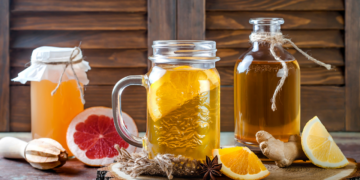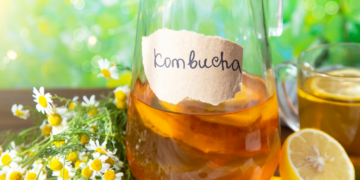Matcha is super green and it’s taking the health world by storm. It’s actually not a new trend that’s recently become popular. In fact, it’s been a part of Japanese culture for over 400 years where it’s used in Japanese green tea ceremonies.
Unlike standard green tea where you steep the leaves and drink the liquid, matcha is made from the whole tea leaf and comes as a green powder, which you whisk with hot water and end up with a tea with a rich green color that has a slightly vegetal taste. You can even bake with the powder or use it to make green tea cappuccinos.
So, what does matcha taste like?
Matcha tastes similar to green tea because they’re essentially the same thing. However as ceremonial grade matcha has more chlorophyll than green tea, many describe the taste as a mild grassy taste similar to seaweed.
Green tea is made from the leaves of the Camellia sinensis while matcha powder is derived from the ground leaves of the exact same plant. In making matcha the plants are shielded from the sun before being harvested to encourage more chlorophyll pigment (fun fact: this is why matcha has such a vibrant green color).
Is Matcha Supposed To Taste Good?
For many people, matcha is an acquired taste. But if you’ve been drinking matcha consistently, and still don’t like it, there could be something else at play. If you’ve never tried it, and are wondering what does matcha tastes like; good matcha will taste smooth, buttery, and somewhat sweeter than green tea. People often describe matcha green tea as grassy. Matcha has an ever-so-slightly thicker consistency than green tea; this is because the matcha powder infusers thoroughly with the water, unlike steeping a green tea bag in boiling water.
The quality of the matcha makes a huge difference when it comes to taste so if you think it tastes bad, it could be that you haven’t gotten good quality tea. Ceremonial grade matcha or culinary grade matcha – while pricey – tastes considerably better. Matcha is not supposed to taste bad but it’s also not meant to taste particularly good either, or at least, not very sweet like iced tea or a smoothie.
Matcha can taste exceptionally bad if you are not brewing it correctly. You cannot brew it like a regular cup of tea. The matcha first needs to be whisked in a little bit of water before the remainder of the warm – or cold – water is added to the drink. It may seem like an arbitrary extra step, but it makes a difference. The water added to matcha should not be boiling hot as this can also ruin the taste.
How To Make Your Matcha Taste Good
Buy High-Quality Matcha
First, make sure you’re buying high-quality matcha. There are 4 kinds of Matcha green tea: Tencha, Koicha, Usucha, and Hiyasu. Every kind has a different purpose in the tea-drinking ceremony. There is a fifth kind of matcha that is called “culinary grade”, which has no ceremonial value and is used when making things like matcha cookies or muffins. You don’t have to buy the most expensive matcha, but don’t choose the cheapest either. It may take some experimentation to find the right one for you. Higher quality matcha will have a better flavor, but it may also contain higher levels of beneficial polyphenol antioxidants. Good quality matcha:
• Should be a powder the texture of baby powder.
• Shouldn’t be dark in color as that indicates low quality.
• Should be a vibrant shade of green.
Drinking matcha is a little bit more than simply pouring hot water over powder. It’s a whole different ball game, like drinking a fine wine or sipping on the most beautifully blended cognac ever. So, choose wisely and prepare mindfully.
The best ceremonial matcha tea comes from Japan. You can find Chinese versions that are cheaper, but they usually don’t taste as good. Also, matcha tea powder, even organic culinary grade matcha powder, can contain unhealthy amounts of lead. The plant takes up lead easily from the soil, and you consume the whole leaf. If possible, buy a brand that undergoes independent testing for heavy metals and impurities. Don’t overdo it, and don’t give it to a child since they’re more susceptible to even small quantities of lead.
Add Some Flavoring
When making a matcha latte, embellish it with some flavoring. Vanilla coffee syrup or a small amount of vanilla extract will add a pleasing flavor. Another coffee syrup flavor that goes well with matcha is cantaloupe coffee syrup flavoring. Experiment with several flavors of coffee syrup and see which appeals to you most.
If you don’t like matcha in tea form or as a latte, look for recipes online for baking with matcha. You can add matcha to a pancake mix for green pancakes with extra health benefits, make matcha cookies, and even add matcha to homemade dark chocolate. Some people sprinkle a little into their morning bowl of porridge or stir it into a container of yogurt.
Dairy and non-dairy puddings made with matcha and cocoa powder are popular too. How about adding a pinch to a fruity smoothie? Every day, people are coming up with new recipes that use matcha powder. Explore and experiment.
Another way to get the health benefits of matcha if you’re not crazy about the flavor is to add a small amount of matcha powder to a spice shaker that contains a spice mixture. With the other spices, you won’t notice the flavor but will still get the health benefits.
Also, try a squirt of lemon in matcha tea. The citrus will mask the bitter notes and give it a livelier flavor. There’s another perk – citrus also enhances absorption of the antioxidants in green tea.
Add Some Fat
In the age of “bulletproof,” it’s also popular to add some fat to matcha. One of the most popular is to add a teaspoon of medium-chain triglyceride oil, perfect if you’re on a keto diet. Plus, adding fat helps you better absorb the fat-soluble vitamins.
Other FAQ
Does Matcha Taste Better Hot Or Cold
If made right, matcha tastes good hot or cold. However, cold matcha might be preferable. It seems to come out less bitter. Boiling water can ruin the flavor of matcha, leaving your drink tasting burnt and dull.
Many people don’t like hot matcha because they’re actually brewing it wrong. Bitter matcha is usually due to poor quality tea or from burning your drink with boiling water.
What Flavors go well with Matcha
There are lots of flavors that go well with matcha.
Chocolate and matcha are a match made in heaven because it makes the flavor richer, and take the edge off the grassy notes. You might notice that lots of candy and desserts in Japan combine matcha with chocolate – for good reason!
Lemon also pairs well with matcha. It helps to add some bright notes to matcha’s grassy flavor. It has the added bonus of making this health drink even healthier. Some research notes that adding citrus to matcha tea helped to increase the number of catechins in the tea the body could absorb. Catechins are compounds that act as antioxidants. So this is a win-win.
Vanilla can also add some sweetness to matcha. Many people add a vanilla pod or some vanilla flavor syrup to their matcha tea to cover the vegetal aromas and slight bitterness.
Honey can also add some sweetness to matcha tea while helping to dull down the vegetal taste.
Although you can use any milk in a matcha latte. Almond milk is a big hit because it’s naturally sweet. The almond can help to mask some of the slightly bitter taste and add a bright nutty flavor.
Believe it or not, coconut can also go well with matcha green tea. As mentioned earlier, combining fats with matcha can improve the taste and help reap the benefits of fat-soluble vitamins. Coconut is a good source of healthy fatty acids. This is why you might notice some coconut milk matcha lattes on cafe menus (some recipes even suggest adding coconut oil too!)
Do More People Prefer The Taste Of Matcha To Green Tea?
Taste is subjective, so some people will like one of these teas more than the other. Matcha seems to be a lot trendier than green tea. Personally, I much prefer a good quality ceremonial matcha tea to any standard green tea. Matcha has grown beyond tea with matcha lattes, bubble tea, candy, and desserts hitting the market, so it wouldn’t be so popular if people didn’t like it. Plus, it’s a little bit sweeter and creamier than regular green tea, which is why many people prefer it.
Why Drink Matcha Anyway? What are its Benefits?
Matcha is rich in antioxidants called polyphenols, which are linked with protection against heart disease and cancer in some studies, although more research is needed. Some studies find that it may modestly improve blood sugar control too.
Plus, matcha green tea provides a gentler state of alertness compared to coffee. It contains caffeine, but the amount is less than in a cup of coffee. Additionally, it contains theanine, an amino acid that calms your mind by activating a neurotransmitter called GABA. With theanine in the mix, you get a relaxed state of alertness rather than the jitters. There are a lot of reasons why you should drink matcha: improved memory, energy levels, mood, focus, and productivity.
With possible benefits like these, it’s not surprising that people drink matcha tea for its health benefits. The downside is not everyone appreciates the taste. It has a somewhat grassy taste that some love, but others can live without. Are there ways to make matcha taste better?
The Bottom Line
Matcha, a finely ground powder of green tea leaves, is the perfect solution to stay energized and alert throughout the day. Now you know some ways to make it more flavorful and best enjoy its health benefits. The most important aspect of preparing matcha is the drinking. Drinking matcha is like a ceremony. It’s a way to relax, meditate and enjoy the whole mind-body connection that you get from combining the ritual of preparation, the flavor of matcha, and the sense of calm energy it brings. Enjoy!







